Avoid These Baking Blunders: Common Mistakes and Fixes
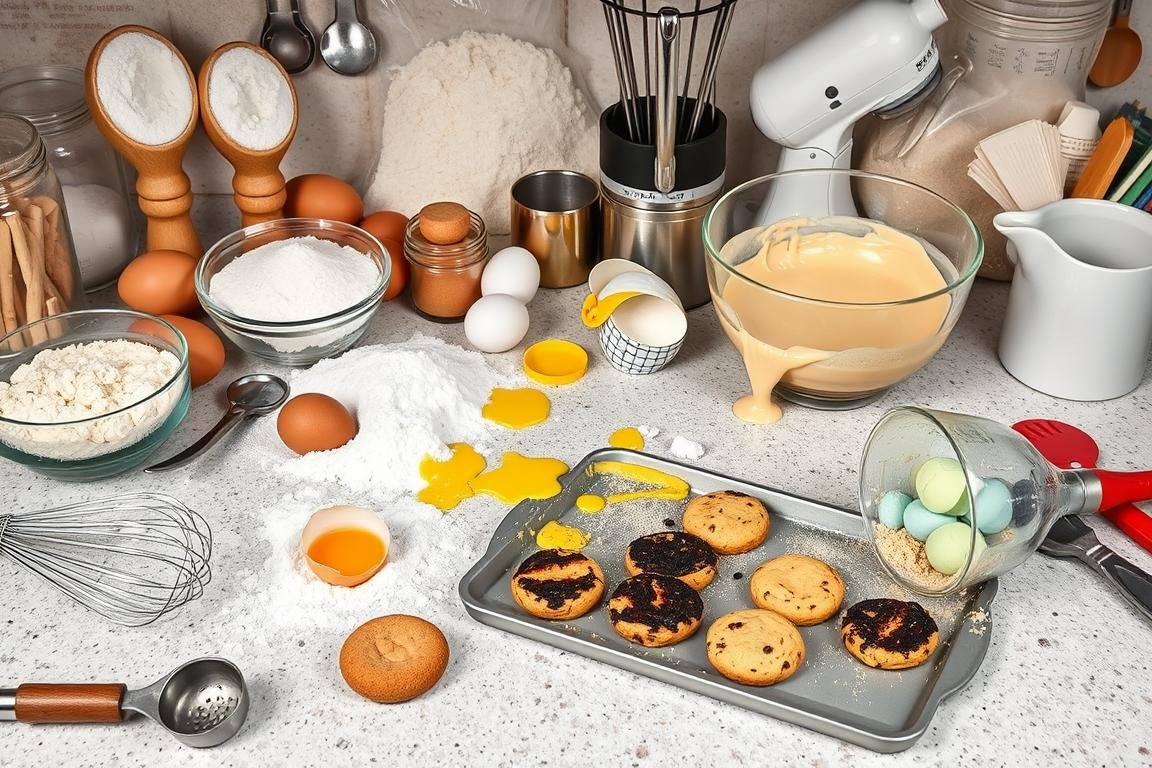
Ever wondered why simple baking recipes can end in disaster? Keep dessert disasters at bay with tips on common baking mistakes. Whether facing a sunken soufflé or uneven biscuits, we’ll show the way to flawless baking. Discover how to make treats stand out. Join us to learn the baking fundamentals for turning simple ingredients into something special.
Key Takeaways
- Recognize how improper oven temperature control can result in uneven baking and texture issues.
- Embrace the precision of weight measurements for ingredient consistency in every bake.
- Learn that restraint in opening the oven door could be the key to well-risen and uniformly baked goods.
- Understand the importance of freshness, particularly with ingredients like yeast, to ensure optimal rise and flavor.
- Explore the distribution of heat in ovens and the role it plays in achieving evenly baked desserts.
- Avoid overmixing to circumvent hard and dense cakes and aim for the just-right texture.
- Discover the significance of allowing baked treats time to cool for perfect slicing and decorating outcomes.
Understanding Common Baking Mistakes
Baking is like a precise science. It needs precise ingredient measurements for consistent results. Let’s look into what can mess up your baking.
What Constitutes a Baking Mistake?
Mistakes happen when you don’t follow the basic baking ingredients and their amounts. Mixing dough too much or using the wrong oven temperature can mess things up. For instance, too much mixing makes your cakes hard. And not heating your oven right can make food cook uneven and not rise.
Why Baking Precision Matters
In baking, being exact is a must. Each ingredient has its job. For example, baking soda and powder make cakes rise, but they do it differently. At Miss Kim’s, they measure ingredients in grams for the best results. Small mistakes can change how ingredients work together, ruining your baking.
| Common Error | Potential Consequence | Preventative Tip |
|---|---|---|
| Using expired baking ingredients | Leads to inactive leaveners and stale flavors | Regularly check and refresh your pantry stock |
| Incorrect ingredient measurements | Can result in dense or overly fragile structures | Use a digital scale for precise measurement |
| Opening the oven frequently | Causes temperature fluctuations, risking a fallen structure | Use oven lights to check progress instead |
Knowing these mistakes and being strict in your baking can give you great results. Remember, every detail is important in baking.
Skipping Ingredients or Altering Ratios
When you bake, every ingredient matters, from baking soda to the vanilla extract. Changing the list by skipping or altering amounts can give unexpected outcomes. Let’s talk about why you should stick to recipes and how wrong substitutions can mess things up.
The Importance of Following the Recipe
Recipes make sure the end product tastes and feels just right. Sticking to them maintains the needed scientific balance. For example, messing up the amounts of butter or milk can ruin your cake’s moisture and texture.
Common Substitutions and Their Consequences
Substitutions are sometimes necessary, but they can change things. For example, baking soda and baking powder are not the same. Swapping one for the other without adding anything can mess up your baked goods.
Butter is often swapped out for other things, like margarine or shortening. Each option changes your bake in small ways. It’s all about the science behind these changes:
1 cup butter = 1 cup margarine or = 1 cup vegetable shortening + ½ teaspoon salt, or = 7/8 cup lard + ½ teaspoon salt.
Milk and vanilla aren’t just for taste; they also impact texture and color. Using water and butter instead of milk can make your cake less tender. This happens because of changes in fat and protein.
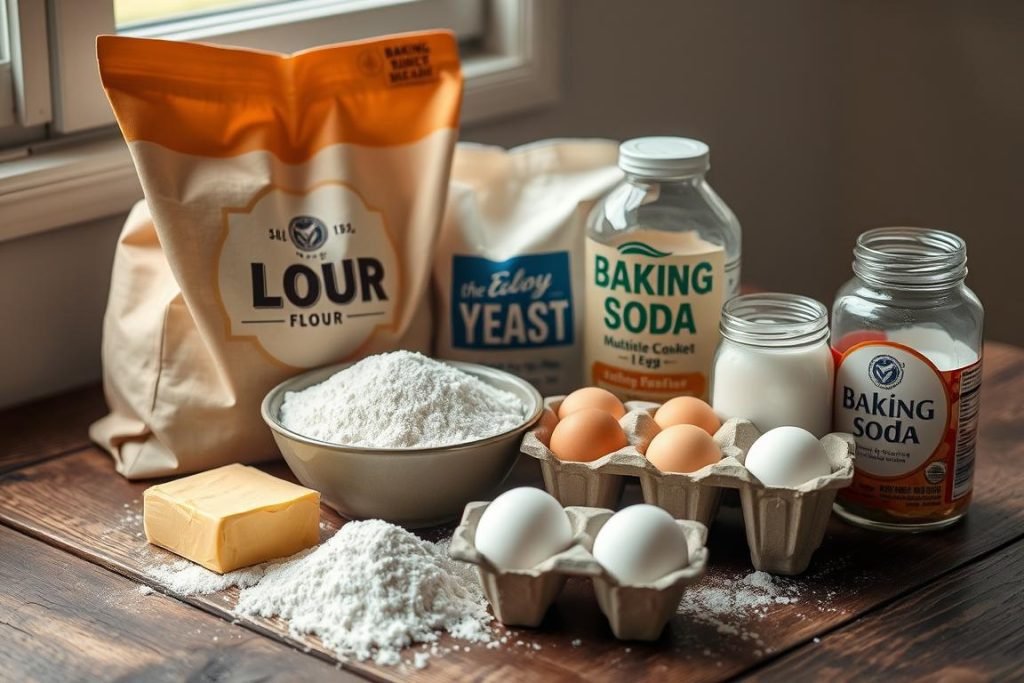
In short, it’s tempting to swap ingredients like baking soda, butter, milk, or vanilla. But knowing what each one does helps keep your baking on track. This ensures you get the taste, texture, and rise you want.
Overmixing or Undermixing Dough
Getting your dough just right means not mixing it too much or too little. You have to find the perfect balance to make sure the gluten activation and batter consistency are on point. This balance is super important for how your baked treats turn out. Here’s where you’ll learn about the importance of mixing techniques.
Signs of Overmixed Dough
It’s important to recognize when you’ve mixed your dough too much. If your dough looks tight and shiny, that’s bad. It means the gluten has gone into overdrive. This can make your cakes or cookies too dense and not fluffy. If the center of your baked goods sinks, it’s a sign of overmixing.
Techniques for Proper Mixing
The right mixing methods can really up your baking game. Begin by mixing butter and sugar just right. You want it airy but not too fluffy, stick to under three minutes. Add eggs slowly and don’t mix for too long.
Knowing how much to mix is key for things like yeast breads or pastries. For example, yeast dough should be kneaded for 8-10 minutes. It should be smooth and stretchy without overdoing it.
Make sure you mix your dough well to avoid undermixing issues. Proper dough shouldn’t have dry or overly wet spots. Here’s a quick guide for mixing various baked goods:
- Pancakes, muffins, and quick breads: Mix until just right to avoid toughness.
- Yeast breads: Knead until it’s smooth and stretchy for best rise.
- Cakes: Cream butter and sugar just right, then add eggs and flour gently.
- Pie crusts and biscuits: Mix as little as you can to keep them tender.
Be careful not to overmix, especially with sensitive mixtures. Aim for a perfect mix where gluten activation helps the structure but keeps the pastry tender and crumbly. Enjoy your baking!
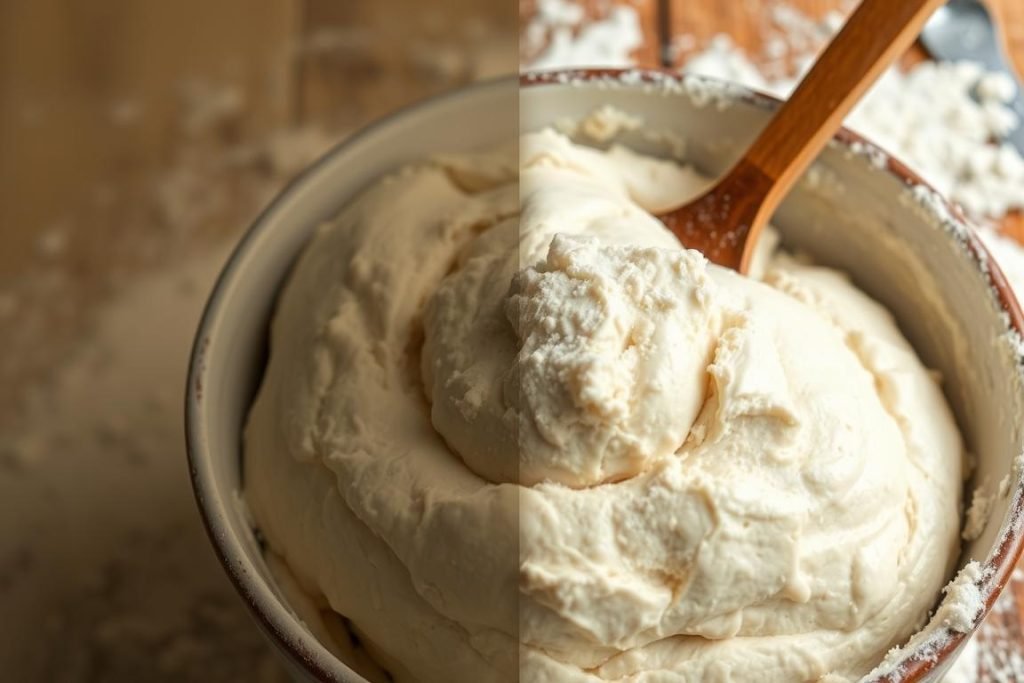
Incorrect Oven Temperature
Uneven baking and undercooked dishes often come from one kitchen mistake: wrong oven temperature. Preheating your oven is key for evenly cooked meals. But the dial alone might not be enough. Many oven thermostats are not accurate.
How to Calibrate Your Oven
Using an oven thermometer can make a big difference. Put a dependable one inside your oven, like an analog dial or a digital probe. It gives a more correct temperature than the built-in thermostats. The Thermoworks Square DOT can check your oven’s air and your food’s inside temperature. This helps stop baking mistakes from uncertain heat.
If there’s a mismatch between your oven’s dial and the thermometer reading, you might need to calibrate manually. Some new ovens have settings for this. If not, adjust your baking temperature based on the thermometer.
The Impact of Temperature on Baking
Oven temperature problems can wreck your baking, like burnt edges or a soggy center. A second thermometer can help you bake better. Also, don’t open the oven door too much. It keeps the temperature stable for even baking.

Knowing these tips can help you bake perfectly every time. Don’t let a wrong oven temperature spoil your cooking. With the right tools, like a good oven thermometer, and knowledge, every dish can turn out great.
Using Expired Ingredients
The freshness of your baking ingredients is key. Especially for baking powder and yeast. Their chemical reactions depend on being fresh. Knowing the shelf life and storage is key. Using expired yeast can ruin your baked goods.
Identifying Expired Baking Ingredients
Wondering if your baking items are too old? Some easy tests can help. For baking powder, just add a teaspoon to hot water. If it bubbles well, it’s good to use. The fizzing shows it can still help your goods rise.
How Fresh Ingredients Enhance Results
Fresh ingredients make sure baking reactions happen right. For cakes, cookies, and bread, these reactions are vital. They decide the texture and rise. For example, fresh baking powder makes cakes soft and fluffy. But, old ingredients mean denser textures.
Proper Storage Tips:
- Keep baking powder in an airtight container, away from sunlight and heat.
- Store unopened baking soda for up to two years, opened ones for six months.
These practices keep your ingredients working right in recipes. They stay effective and fresh.
| Ingredient | Unopened Shelf Life | Opened Shelf Life | Storage Conditions |
|---|---|---|---|
| Baking Powder | 2 years | 6 months | Air tight, away from heat |
| Baking Soda | 2 years | 6 months | Air tight, cool, dry place |
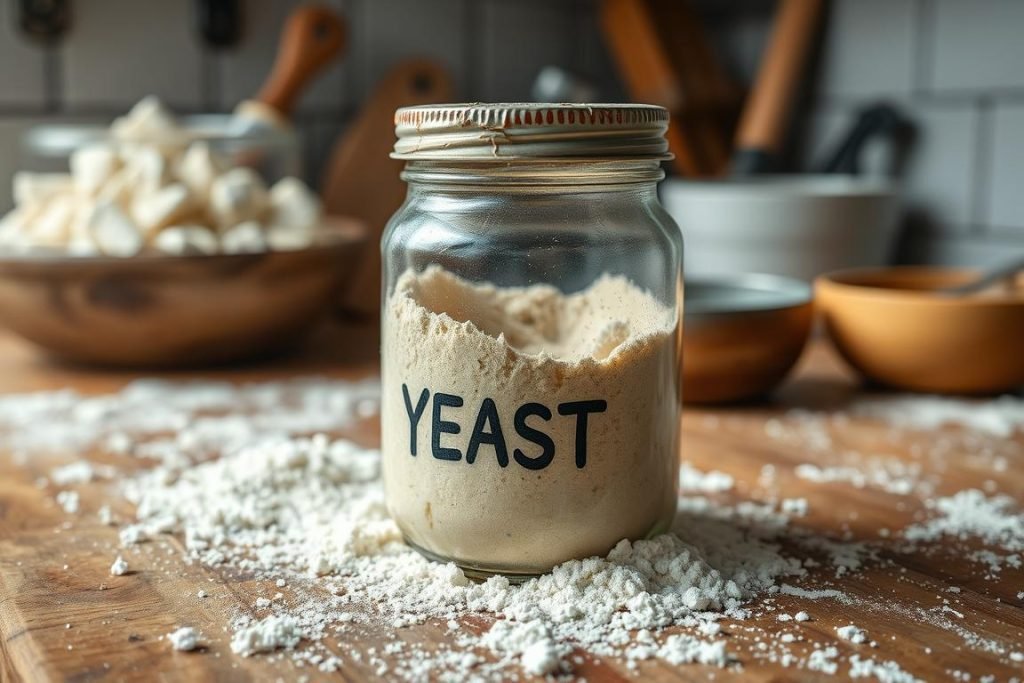
Not Preheating the Oven
Skipping the preheating step is a big mistake in baking. It can ruin your food’s texture and taste. Preheating the oven is key to a perfectly baked item.
Consequences of a Cold Oven
A cold oven can cause your food to cook unevenly. It can make dishes like Fresh Apple Cinnamon Scones and Beautiful Burger Buns come out wrong. But some recipes, like fruit pies and pound cakes, do better starting cold.
Still, most baked goods need a warm oven from the start. This helps with the baking process.
Best Practices for Preheating
It’s important to always preheat your oven right. Aim for 10-15 minutes of preheating to get the correct temperature. Follow these steps for better results:
- Use an oven thermometer to check the temperature because built-in ones can be off.
- Wait until the oven reaches the needed temperature before baking. This helps your food cook evenly.
- Adjust based on what you’re cooking, as some recipes need special temperature settings.
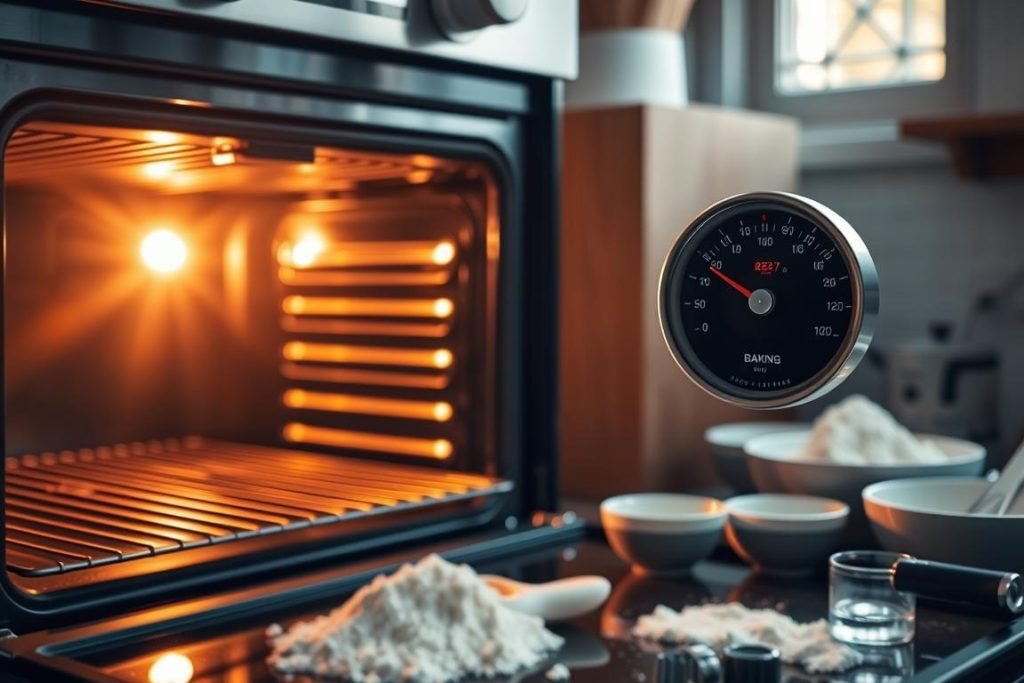
While some recipes are okay starting in a cold oven, most are not. A warm oven is essential for successful baking. Remember, baking is both science and art. Preheating your oven is a crucial step in this process.
Ignoring Pan Preparation
Many bakers skip preparing their pans. This is a big mistake. It can ruin your baked goods. Getting your pan ready is key to removing cakes easily and stopping them from sticking or tearing.
Types of Greasing and Their Uses
Greasing is a must in baking. It keeps your goods from sticking. You might bake a soft sponge cake or thick bread. What you use to grease changes the taste and texture. Butter adds flavor and a nice crust. Yet, oils or shortening work well for their mild taste and can handle high heat. If you don’t want dairy, or want less mess, non-stick sprays are quick and work great.
The Role of Parchment Paper
Parchment paper is key even with greasing. It’s an added safety step. This paper makes sure cakes come out easily. It’s great for wet cakes or detailed shapes where grease alone might fail.
- Parchment paper not only makes removing cakes easier but also helps them bake evenly. It stops the batter from touching the hot pan, which can cook it unevenly.
- Using parchment paper also means less mess to clean. Because it catches most of the crumbs and spills.
- Remember to grease well. Cover the whole pan well, especially the corners and edges. That’s where sticking happens a lot.
Using both grease and parchment paper makes sure your baking shines. They help your kitchen work end in perfect cakes and happy people. Learn which tools and methods work best for you. This way, you’ll always get the best from your oven.
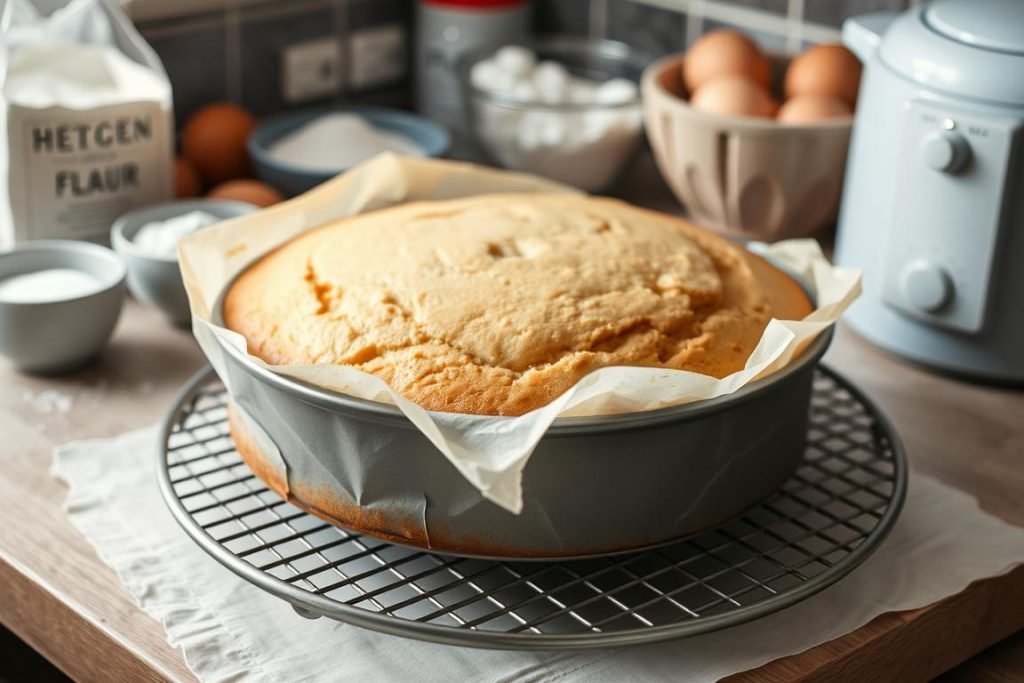
Misjudging Baking Times
Getting the baking time right is key for perfect baked goods. Oven temperature and recipe can change the needed time. It may seem easy but many things can affect it.
Tips for Accurate Baking Time Assessment
Knowing your oven well helps avoid baking time mistakes. Fan ovens are hotter by about 10%. To find the right time:
- Always preheat your oven to the correct temperature before baking to ensure even cooking.
- Place an oven thermometer inside to monitor the actual temperature, as the dial indicator might be misleading.
- If you’re unsure, set the timer for a shorter period than stated and check regularly.
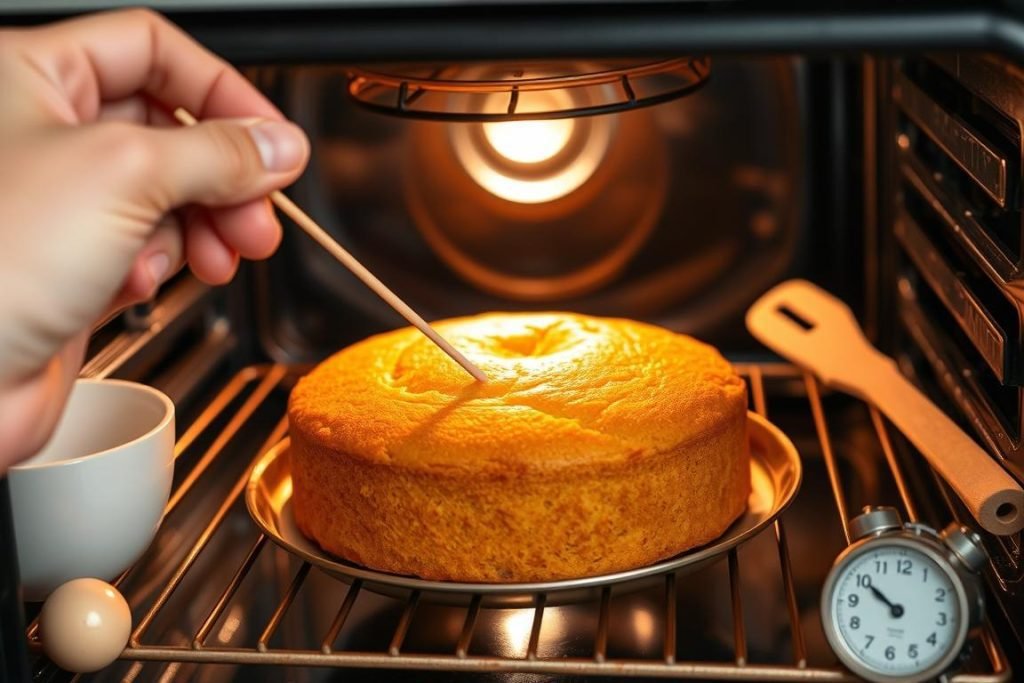
How to Test for Doneness
Proper testing stops undercooking or burning. Each baked item has its own test:
- Cakes: Insert a toothpick into the center. If it comes out clean, your cake is done.
- Bread: Tap the bottom of the loaf. A hollow sound means it’s thoroughly baked.
- Cookies: They should be golden around the edges and set in the middle.
Know that the end signs can change with the recipe and oven. Always watch closely as it finishes.
| Baking Issue | Common Causes | Suggested Fixes |
|---|---|---|
| Underbaked in the middle | Too high oven temperature causing the outside to cook faster than the middle | Lower the oven temperature and increase the baking time |
| Overbrowning | Oven temperature too high | Reduce oven temperature and place a sheet of aluminum foil over the top |
| Uneven baking | Inconsistent oven temperature | Use an oven thermometer to confirm actual temperatures and adjust accordingly |
Learning to judge baking time and doneness leads to great baking results. This improves both flavor and texture.
Using the Wrong Bakeware
Choosing the right bakeware is key in baking. It affects ease of preparation and the final product’s quality. Different materials affect heat conduction, cooking times, and texture. Knowing the differences between metal and glass helps in choosing better for recipes.
Material Matters: Choosing the Right Bakeware
Different materials react to heat in their ways. Metal heats and cools quickly, making it great for precise temperature recipes. Glass holds heat longer for even cooking. But, too long in the oven, and it could overcook or burn food.
Differences Between Metal and Glass Bakeware
The recipe often decides if metal or glass is best. Metal is good for browned or crispy foods like cookies. Perfect for high temperature needs. Glass is better for casseroles, slow cooking to perfection. It keeps flavors deep and even.
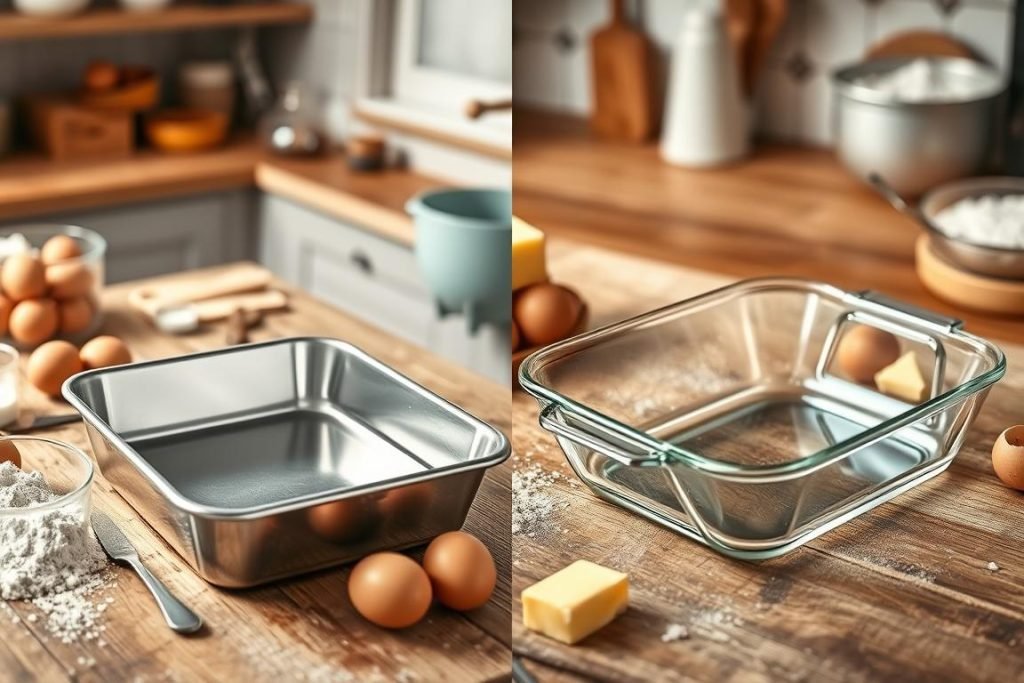
Metal Bakeware: Metal pans heat quickly. They are perfect for cookies and pies needing crisp edges. Good for high temperatures, they are strong for broiling or roasting.
Glass Bakeware: Glass holds heat well, cooking dishes evenly. It avoids the harsh browning metal can cause. Ideal for gentle cooking.
Your bakeware selection should match your cooking needs and recipe requirements. Whether it’s metal’s quick heating or glass’s even cooking, the right choice can make a big difference in baking success.
Not Adjusting for Altitude
When you bake in different places, altitude matters a lot. You need to change some things to get it right. This is because altitude affects how things rise, how hot they get, and the science of baking.
How Altitude Affects Baking
At high places, air pressure is less. So, dough and batter grow faster. Also, liquids boil at lower temperatures, making water evaporate quicker. These things change how your baking turns out. It’s important to know this to bake well at high places.
Tips for High-Altitude Baking Success
There are tricks to bake well up high. Let’s look at what you can do to face these high-place baking troubles:
| Altitude Range (feet) | Leavening Adjustment | Boiling Point of Water | Additional Considerations |
|---|---|---|---|
| 3,000 to 6,000 | Decrease leaveners by 25% | 206.7°F to 203.2°F | Increase oven temp by 15°F |
| 7,000 to 8,000 | Decrease leaveners by 30% | 199°F to 197°F | Reduce sugar, increase liquid |
| Above 8,000 | Consider significant recipe changes | Below 197°F | Extend baking times; lower sugar more |
If you live higher than 3,000 feet, these baking tips are key. They help you control rising and cooking to avoid too dry or too quick bakes.

Making bread or delicate cakes at high altitudes needs extra care. Try watching how they look as they bake. Also, change how much flour and sugar you use. This helps with the high elevation.
Finally, each recipe acts differently when you’re up high. So, remember what works and what doesn’t for next time.
Rushing the Cooling Process
It’s easy to want to decorate or serve your baked treats right away. But rushing the cooling time can hurt your baking success. Being patient is crucial, not just in life but in baking too. Cooling is as important as mixing and baking. It makes sure your goodies are safe to handle. It also lets the flavors settle and textures form.
Importance of Proper Cooling
Why is cooling so important, you might wonder? Skipping it can make cakes soggy instead of fluffy. And if you try to frost a warm cake, you might end up with a mess. The right texture depends on letting things cool down properly. For desserts like cheesecakes and pies, cooling slowly helps avoid cracks.
Techniques for Efficient Cooling
How can you cool things down properly? Start by moving your baked goods to a wire rack right away. This step lets air move around, keeping the bottoms from getting wet. Don’t slice bread or cakes too soon; they’re still cooking a bit after leaving the oven. For cookies, let them sit on the baking sheet briefly before moving them. This prevents them from falling apart. Proper cooling is key to making sure every slice or bite is perfect.